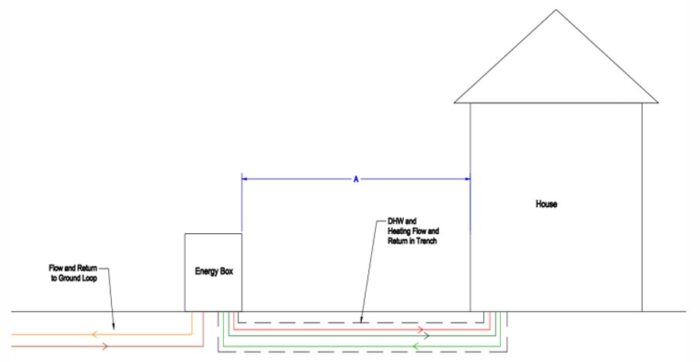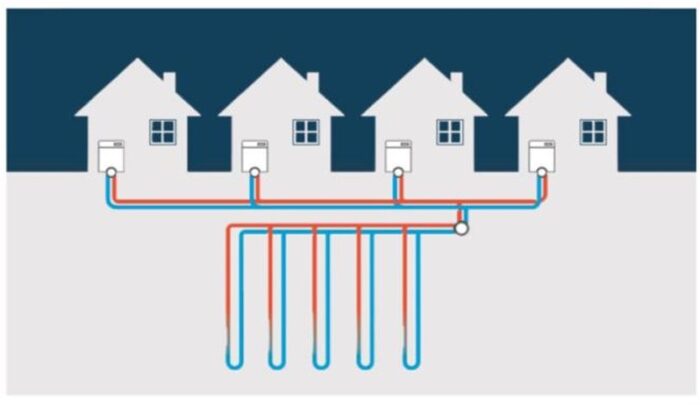
Energy Efficiency Opportunities in GSHPs



As the UK transitions toward net zero, GSHPs are increasingly being recognised as a critical technology to achieve deep decarbonisation in heating and cooling. GSHPs are often referred to as the most energy-efficient heating and cooling systems available today due to their ability to harness stable underground temperatures and deliver substantially more energy than they consume.
This article explores the range of energy efficiency opportunities within the ground source heat pump sector to guide developers, installers, and policymakers toward effective deployment of GSHPs.
The attribute mostly associated with GSHPs is high coefficient of performance (CoP). While high-efficiency gas boilers reach operational efficiencies of around 90–95%, ground source systems currently achieve CoPs exceeding 400% (ratio of 4:1 heat output to electrical input). For every unit of electricity consumed, more than four units of heat energy is produced. This performance derives from the consistent and moderate ground temperature — typically between 8°C and 12°C at depths below 3 metres across much of the UK.
Unlike air source heating, usually exposed to wide temperature fluctuations, GSHPs benefit from thermal inertia, allowing more stable and predictable energy performance throughout the year, reducing energy wastage and peak grid network loads.
Ground source system performance also improves incrementally each year, at a rate of around 2% annually. This “maturity gain” makes GSHPs installations increasingly highly efficient.
While GSHP installations are typically associated with high upfront capital costs, particularly due to borehole drilling and ground loop installation, our company “Drill and Complete” strategy provides a low-cost opportunity to reduce both capital and operating system costs.

This involves pre-planned borehole drilling and GSHP unit completion outside properties, enabling efficient connection of both heating and domestic hot water (DHW) piping circuits. Significantly reducing both complexity and time to install— in domestic and commercial installations—where access, layout constraints, and user disruption can become notable cost drivers.
Combined with a manifolded microgrid heat network — where a centralised array supplies multiple properties — infrastructure costs across several users are minimised. This shared network model enhances scalability and delivers more stable load profiles, improving overall system CoP and unit installation costs.
Other low-cost efficient measures include:
These enhancements can be integrated at low marginal cost, yet unlock significant long-term operational savings and improved system longevity.
Solid-state thermoelectric heat pump module applications offer further efficiency benefits; thermoelectric heat pumps exploit the “Peltier effect” to generate heating or cooling through direct current (DC) power supply. Their compact, lightweight design (approx. 5 kg per kW(th)) makes them uniquely suited to all domestic applications or mobile heating provision.
Due to the compact and modular nature of thermoelectric heat pumps, these units can be seamlessly integrated into custom-designed systems or retrofitted into existing setups without significant alterations. The modular approach facilitates easy scalability, making these systems suitable for a wide range of applications, from small residential units to large industrial facilities.
Key benefits include:
These systems also provide high power factor correction (PFC), ideal for commercial or industrial settings where grid connection costs are tied to kVA rather than kW.
Increased adoption will unlock new segments of the heating market previously deemed unsuitable for GSHPs and applications where traditional heating and cooling systems are not viable.
Pure energy (REGen) Ltd has been working in research into this area for over 18 months and we are currently in process of developing a high efficiency low cost GSHP “Micro-Grid” network.
Recent global energy crises have revealed both vulnerabilities and risks inherent within fossil fuel-based energy markets, whilst amplifying the benefits of the energy transition – including greater energy security, improved air quality, reduced emissions and limited impact of volatile fuel prices.
Initial investments have also been traditionally high; GSHP costs may vary depending on the project and property specifications. With the adoption of a “micro-grid” strategy, we fully expect design and installation costs to rapidly reduce over time.
Battery storage and demand side flexibility also improves the attractiveness of heat pump networks. Innovative supply tariffs will be the mechanism to achieve this, with consumers incentivised to shift demand to off-peak times or for supplier to optimise asset use in exchange for lower energy prices.
Differentiation is critical to capturing the attention and loyalty of potential clients. At Pure energy (REGen) Ltd, we are focused on promoting our technology solutions cost efficient value proposition, to attract and retain customers interested in low carbon heat installations.
We believe we can continue to integrate both existing and new technologies, within an innovative design and installation strategy, making ground source heat supply a more affordable, reliable, efficient, and sustainable choice. As with the majority of technological advancements, we are currently making further improvements in product system efficiency and flexibility by integrating renewable energy sources.
Pure energy (REGen) Ltd has identified key performance indicators from potential customers and are working towards a commercial solution that directly meets customers’ needs, including;
By reducing high upfront costs, incorporating efficient retrofit connections and delivering negative global warming potential (GWP) technology, ground source heat networks will compete more favourably in the marketplace.

An important consideration when designing, installing, or investing in a GSHP network is to build in design flexibility from the outset. This includes:
A future-proof system not only performs efficiently today but remains adaptable to policy shifts, user needs, and new technologies for decades to come.
We also believe heat pump service models for this technology application to also be promising; with suppliers selling assets (e.g. heat pump, storage, or an electric vehicle) and electricity as a bundled package – similar to a mobile phone contract framework. This approach is increasingly seen as an important development market opportunity for decarbonised electricity networks, where consumer flexibility and efficiency become an increasingly valuable revenue channel.
The UK should now be in a phase of rapid investment and delivery. For example, by 2030, approximately 10% of existing homes in the UK needs to be heated by a form of heat pump technology, compared to only approximately 1% today. Yet almost all indicators for low-carbon technology roll-out remains seriously off track, with deployment rates needed to significantly be ramped up.
Ground source heat pumps represent a transformative opportunity in the decarbonisation of heat—one of the most challenging sectors of the UK’s net zero pathway. Their energy efficiency, enhanced by innovative strategies such as our “Drill and Complete” strategy, microgrid installation, and solid-state heat modules, will become the most efficient, reliable, scalable and sustainable form of low-carbon heating available to customers today.
By 2030, heat pump technology solutions will have the potential to reduce carbon dioxide emissions by at least 500 million tonnes globally. The UK Government has allocated £192 million of the appropriated Defence Production Act funds to support manufacturing and deployment of electric heat pumps, providing technology that enhances high-efficiency heating in freezing temperatures without producing greenhouse gas emissions.
To realise the full potential of ground source heat networks, the sector must continue to champion standardised, replicable solutions that reduce upfront costs, accelerate delivery, and enable new financing models such as “Heat as a Service.” These advances will ensure GSHPs not only compete in the low-carbon marketplace but lead it.
Given the above, the future of heat pumps is not just bright; it’s essential.

During Alan’s 25-year career he has held a number of posts in FTSE 100 energy companies in both Senior Management roles and latterly as a Technical Consultant. Alan founded renewable energy integrated solutions company Pure energy (REGen) Ltd to add value to clean energy project developments, now operating in both the UK and EU.
Services (UK/International)
Technologies